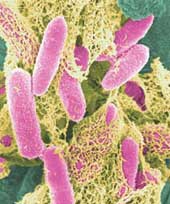
 This is a guest post by Dr. Erik McLaughlin.
This is a guest post by Dr. Erik McLaughlin.
**********
Traveler’s Diarrhea: The Basics
Known around the world by many names including a??Montezumaa??s revenge,a?? a??Delhi bellya?? and a??mummy tummy,a?? travelera??s diarrhea (TD) is the most common illness faced by travelers. Nothing can slow down a fun trip as easily as TD — and it can also have serious health implications. TD typically lasts four to six days, and 90 percent of cases occur within the first two weeks of travel.
Anatomy You Need to Know
The gastrointestinal tract starts at the mouth and ends at the anus. After food enters the mouth, it passes through the esophagus to the stomach, where it sits for approximately 45 minutes. After being broken down by gastric secretions, food matter enters the small intestine (duodenum, jejunum, and ileum in order). The small intestine is the site where most nutrients are absorbed by the body. From the small intestine, food matter begins to look more like feces as it progresses to the large intestine or colon. The colon absorbs water from the food material before the material passes through the anus and exits the body as feces.
Symptoms
Recognizing the warning signs of TD, such as blood in the stool, fever, or abdominal cramping, can help a savvy traveler know when to seek medical help.
TD has many definitions; the presence of three or more loose-formed stools in one day is a good one. Abdominal cramping, nausea, vomiting and fever may also occur. The presence of blood in the stool can indicate that infection has directly damaged the intestinal wall and should be taken seriously.
Clinical Diagnosis??and??Complications
Diagnosis of TD is largely based on symptoms. The presence of blood in the stool may indicate that there is an invasive process damaging the intestinal lining. As previously mentioned, this should be taken seriously. Diarrhea that is accompanied by fevers and severe abdominal cramping may also signal a more serious form of illness and should prompt the afflicted individual to seek medical care.
Typical travelera??s diarrhea is loose and watery. Some doctors advise a a??let it flowa?? approach with the reasoning that diarrhea is the bodya??s way of excreting the infectious agent that causes the symptoms. While this can be an inconvenient way to deal with diarrhea, it can also be a good approach, providing there are no warning signs indicating a serious debilitating infection, fluid losses are not excessive (such as with cholera), and the person continues to drink large amounts of fluids sufficient to keep pace with fluid losses and to avoid dehydration.
Warning signs of a serious diarrheal infection include fever, blood in the stool, massive fluid loss, and/or severe abdominal cramping. The most serious of these signs are blood in the stool or massive fluid loss. Bloody diarrhea indicates that the lining of the intestines is being damaged or penetrated by the causative agent, and massive fluid losses suggest cholera. Any time the intestinal lining is compromised, the possibility exists for a systemic infection. Should a traveler suffer from bloody diarrhea, a visit to a health care provider is advised if possible. This type of diarrhea typically requires treatment with an antibiotic, and may require tests to determine the exact cause.
Causes
The most common cause of travelera??s diarrhea is the gram negative bacterium enterotoxic Escherichia coli (E. coli or ETEC — seen pictured above). This bacterium has been implicated in up to 70 percent of the cases of travelera??s diarrhea worldwide. Campylobacter species, specifically C. jejuni, are considered the second most common cause (30 percent). This organism appears to have seasonal peaks. For example, in the U.S., C. jejuni infections peak during summer months, while in northern Africa, the peak occurs during drier winter months.
Other less common bacterial causes of travelera??s diarrhea include Salmonella, Shigella, Vibrio species (e.g., V. cholera and V. parahemolyticus), and Yersinia enterocolitica. These bacteria occur in up to 15 percent of cases.
Viral infections are estimated to cause 20 percent of TD cases in adults, with the Norwalk virus being a common agent, especially on cruise ships. Rotavirus and hepatitis A and E can also cause diarrhea in travelers. Rotavirus infection is more often seen in children than in adults.
Parasitic infections can also be causes of travelera??s diarrhea. Of these, infections with protozoans are considered most common. Giardia lamblia, Cryptosporidium, Cyclospora, Entamoeba and Isospora species are implicated in roughly five percent of TD cases. Less common causes of travelera??s diarrhea can include helminthic infections, food poisoning, and seafood toxidromes.
Care and Treatment
The most important treatment for travelera??s diarrhea is to ensure adequate hydration. Dehydration is very common in persons who suffer from TD due to the large amounts of water that are lost via loose stools. Oral rehydration with sports drinks and clean, disinfected water should be started the moment that diarrhea strikes. Depending on the causes of the diarrhea, antibiotics may be required to kill bacteria or parasites. Using anti-diarrheal medications to prevent frequent trips to the toilet has a role, but should be done with caution. Preventing the infectious diarrhea from leaving onea??s body may retain the bacteria or parasites in the intestines, allowing them more time to do damage. It is important to have a reasonable degree of certainty about the type of diarrhea before starting antibiotic therapy.
Diarrhea Evaluation in the Returned Traveler
Further studies into the cause of the travelera??s diarrhea start with a thorough travel history, focusing on destinations and eating habits/history. The majority of classical TD cases occur within the first two weeks of travel and last four to six days. Thus, a typical traveler with complaints of diarrhea upon return home will likely be suffering from recurrent or prolonged diarrhea. Only five to 10 percent of travelers have TD symptoms lasting longer than two weeks.
Initial laboratory investigations into diarrhea in a traveler by health care providers may include electrolyte determinations and stool studies looking for the presence of fecal red blood cells, white blood cells, ova and parasite studies, and bacterial culture.
Anatomy and Diet
Knowledge of intestinal anatomy and physiology is important in understanding proper dietary modifications and treatment for those affected by travelera??s diarrhea. The inner lining of the wall of the small intestine is lined with a a??brush bordera?? that contains enzymes to assist in food digestion. When someone suffers from diarrhea, this brush border is frequently damaged and excreted with the diarrhea.
Lactase, which is the enzyme that breaks down lactose (found in dairy products), is one of the enzymes in the brush border, and it can be particularly fragile. When the brush border is damaged, the victim can no longer digest lactose as effectively as before the diarrheal illness.
Thus, food containing lactose in their intestines goes undigested and can act as an osmotic attractant to water. Basically, the undigested bits of dairy food (cheese, milk, etc.) draw more water than normal into the intestine, causing increased diarrhea and water loss. Avoidance of dairy products during diarrheal illnesses should be considered. After a few days to one week of no symptoms, the brush border typically re-grows to the level it was at prior to the diarrheal illness.
**********
 Erik McLaughlin, MD, MPH is a medical doctor who specializes in travel and expedition medicine. Erik is the Medical Director of the Adventure Doc Clinic based in Tucson, Arizona.
Erik McLaughlin, MD, MPH is a medical doctor who specializes in travel and expedition medicine. Erik is the Medical Director of the Adventure Doc Clinic based in Tucson, Arizona.
Before going to medical school, Erik was a professional outdoor athlete, competing in adventure races and multi-sport endurance events around the world. His interest in medicine came from taking care of his teammates during these remote events. In addition to his qualifications as a medical doctor, Erik has completed a Masters in Public Health in International Health and the Diploma Course in Travel and Tropical Medicine.
Erik works part time as a rural emergency physician in southern Arizona as well as acting as a travel and expedition medicine consultant. He also provides educational modules on remote and expeditionary medicine. He is an active member of the Wilderness Medical Society, The International Society of Travel Medicine, The Australian Society of Ruraland Remote Medicine, and a Fellow of the Royal Society of Tropical Medicine and Hygiene.
This post, Travelera??s Diarrhea: The Basics, was originally published on
Healthine.com by Paul Auerbach, M.D..
No comments:
Post a Comment